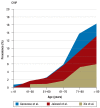Clonal Hematopoiesis of Indeterminate Potential
- PMID: 27215596
- PMCID: PMC4961884
- DOI: 10.3238/arztebl.2016.0317
Clonal Hematopoiesis of Indeterminate Potential
Abstract
Background: Patients with cytopenia are increasingly undergoing molecular genetic tests of periperal blood or bone marrow for diagnostic purposes. These tests can detect genetic mutations that do not have any morphological correlate in hematologic neoplasia such as myelo - dysplastic syndrome (MDS). A new entity was recently defined to lessen the risk of incorrect diagnoses of MDS. This new entity is a potential precursor of myeloid diseases, analogously to monoclonal gammopathy of undetermined significance as a potential precursor of multiple myeloma.
Methods: This review is based on pertinent articles retrieved by a selective search in PubMed employing the terms "clonal hematopoiesis," "acute myeloid leukemia," and "myelodysplastic syndrome."
Results: Clonal hematopoiesis of indeterminate potential (CHIP) is a new entity in which somatic mutations are found in cells of the blood or bone marrow, but no other criteria for hematologic neoplasia are met. Its prevalence rises with age and is roughly 10% among persons aged 70 to 80. It is estimated that, in Germany, about 2.75 million people are affected. The most common mutation is on the DNMT3A gene, followed by TET2 and ASXL1. The rate of transformation to a hematological neoplasia is 0.5-1% per year, and thus about 13 times higher than the incidence of such neoplasias in general. If CHIP is discovered incidentally in a patient with a normal blood count, a complete blood count with differential should be repeated three months later and then at annual intervals.
Conclusion: CHIP must be included in the differential diagnosis of peripheral blood cytopenia. This new entity can help us understand the clinical significance of clonal hematopoiesis.
Figures




Similar articles
-
Clonal hematopoiesis of indeterminate potential and its distinction from myelodysplastic syndromes.Blood. 2015 Jul 2;126(1):9-16. doi: 10.1182/blood-2015-03-631747. Epub 2015 Apr 30. Blood. 2015. PMID: 25931582 Free PMC article.
-
The shadowlands of MDS: idiopathic cytopenias of undetermined significance (ICUS) and clonal hematopoiesis of indeterminate potential (CHIP).Hematology Am Soc Hematol Educ Program. 2015;2015:299-307. doi: 10.1182/asheducation-2015.1.299. Hematology Am Soc Hematol Educ Program. 2015. PMID: 26637737
-
Diagnostic Challenge and Clinical Dilemma: The Long Reach of Clonal Hematopoiesis.Clin Chem. 2021 Aug 5;67(8):1062-1070. doi: 10.1093/clinchem/hvab105. Clin Chem. 2021. PMID: 34263288 Review.
-
A Synopsis Clonal Hematopoiesis of Indeterminate Potential in Hematology.Cancers (Basel). 2022 Jul 28;14(15):3663. doi: 10.3390/cancers14153663. Cancers (Basel). 2022. PMID: 35954328 Free PMC article. Review.
-
Current Aspects of Clonal Hematopoiesis: Implications for Clinical Diagnosis.Ann Lab Med. 2019 Nov;39(6):509-514. doi: 10.3343/alm.2019.39.6.509. Ann Lab Med. 2019. PMID: 31240877 Free PMC article. Review.
Cited by
-
Age-related Disease: A Revolution Is Coming.Integr Med (Encinitas). 2018 Apr;17(2):12-15. Integr Med (Encinitas). 2018. PMID: 30962780 Free PMC article.
-
Inflammation as a Therapeutic Target in Atherosclerosis.J Clin Med. 2019 Jul 26;8(8):1109. doi: 10.3390/jcm8081109. J Clin Med. 2019. PMID: 31357404 Free PMC article. Review.
-
Clonal hematopoiesis.Semin Hematol. 2017 Jan;54(1):43-50. doi: 10.1053/j.seminhematol.2016.10.002. Epub 2016 Oct 20. Semin Hematol. 2017. PMID: 28088988 Free PMC article. Review.
-
Epigenetic and proteomic signatures associate with clonal hematopoiesis expansion rate.Nat Aging. 2024 Aug;4(8):1043-1052. doi: 10.1038/s43587-024-00647-7. Epub 2024 Jun 4. Nat Aging. 2024. PMID: 38834882 Free PMC article.
-
Individual and Neighborhood-level Socioeconomic Status and Somatic Mutations Associated With Increased Risk of Cardiovascular Disease and Mortality: A Cross-Sectional Analysis in the Women's Health Initiative.Womens Health Issues. 2024 Mar-Apr;34(2):197-207. doi: 10.1016/j.whi.2023.10.005. Epub 2023 Dec 6. Womens Health Issues. 2024. PMID: 38061917 Free PMC article.
References
-
- Abkowitz JL, Catlin SN, McCallie MT, Guttorp P. Evidence that the number of hematopoietic stem cells per animal is conserved in mammals. Blood. 2002;100:2665–2667. - PubMed
-
- Thol F, Damm F, Lüdeking A, et al. Incidence and prognostic influence of DNMT3A mutations in acute myeloid leukemia. J Clin Oncol. 2011;29:2889–2896. - PubMed
Publication types
MeSH terms
LinkOut - more resources
Full Text Sources
Other Literature Sources
Medical
Research Materials
Miscellaneous

